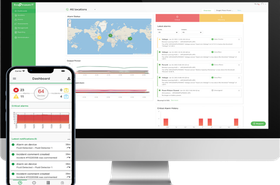I recently revisited the thriller, Jaws. The movie was released 49 years ago on June 20, 1975, and the book 50 years ago. Like many others, I love this story – the water looks calm, but danger lurks beneath the surface as a great white shark makes local waters its home, terrorizing a beach community. Characters with different personalities approach the threat differently, leading to chaos.
I believe this is a great analogy for how organizations may have different ‘personalities’ in responding to the ongoing threats to their IT infrastructure. These threats are like the shark in Jaws – you know they are out there, you generally can’t anticipate them, and when they attack, they may cause significant damage.
Unlike in Jaws, more than one shark is lurking under the surface.
For CIOs, multiple threats are lurking
We know CIOs need to improve how they manage their sprawling, hybrid IT infrastructure and understand the number of assets they have on the network. They need to maintain resiliency and avoid outages that may disrupt business continuity, resulting in lost revenue and potential reputation damage. They are grappling with cyber threats and potential attacks while ensuring firmware is up-to-date and that they are following their company’s security policies.
If that isn’t enough, we argue, they will be increasingly questioned on the energy consumption of their IT infrastructure and may, if global trends continue, need to report their sustainability metrics.
Many CIOs are turning to data center infrastructure management (DCIM) software, specifically EcoStruxure IT, for answers. I believe Jaws – the personalities of its central characters and the threat of the cinematic shark (very different from actual sharks) that made everyone scared to go in the water – offers a few lessons about managing a fearsome threat. I’m not sure spoiler alerts are needed for a film nearly 50 years old, but consider yourself warned.
Probing for IT infrastructure vulnerabilities to exploit
Jaws has three central characters, all determined to defeat the shark, which swims around, probing for vulnerabilities to exploit. Each character is essential to the story’s outcome, with their unique approach to finding and killing the shark.
Oceanographer Hooper is fascinated by the shark and is an intellectual. More comfortable on yachts than fishing vessels, Hooper relies on technology to address the threat. He has the latest electronic equipment and, in a famous scene, he sinks into the water in a shark cage. In the book, unlike the movie, Hooper dies after going into the cage.
Quint is a modern-day Captain Ahab. He is obsessed with sharks and, in another famous scene, he details his experience on the U.S.S. Indianapolis when it sank in July 1945. Quint is ‘old school’. He rejects Hooper’s technology, relies on an old, trusty boat with barrels, and is hell-bent on revenge on all sharks. He respects the shark but believes in, and only in, his tried-and-true approach. Quint gets eaten by the shark in both the movie and the book.
Police Chief Brody is arguably the most traditional character. He sees the chaos the shark is wreaking on the community and works to restore authority and calm from the chaos. He is concerned the community won’t survive without the summer season tourism. He is pragmatic and works hard, trying to find ways to solve the problem.
The drawback of Brody is that he fears the unknown – he doesn’t know how to swim and tends to be slow to move. Yet he eventually faces these fears and brings his pragmatism to the other characters, telling Quint, in perhaps the most famous line from the movie, “You’re gonna need a bigger boat”. Brody learns from Quint and Hooper and becomes the hero who kills the shark and survives to fight another day.
Is your organization like Hooper, Quint, or Brody?
So, what can we learn from the approaches of the main characters – what do their personalities mean for the threat and what is a best practice? When it comes to the threats facing your IT infrastructure, are you like Hooper, Quint, or Brody?
Hooper is forward-thinking by looking to technology for answers, but he is arrogant in believing that technology alone will defeat the shark because it isn’t enough. At the opposite end of the spectrum is Quint, who knows so much and has loads of experience but learns his old-school ways aren’t sufficient for the threat. Then there is pragmatic Brody, who evolves as the film progresses. Learning from Hooper and Quint, Brody perseveres, overcomes his fears, and lives to tell the story.
To create a well-rounded approach, I believe we need to pull from the best traits of Hooper, Quint, and Brody: embrace new technology like Hooper; respect the tried and true that has worked in the past like Quint; and be pragmatic, hardworking, and diligent like Brody. I would argue that most IT organizations swing between these three personalities, driving a multitude of debates on the best approach... like the chaos the shark generates in the beach community.
How DCIM can help CIOs with their IT infrastructure
DCIM is a tool that can help CIOs face the sharks lurking out there as they constantly move, feed, and look for their next victims.
Like Hooper, our team at Schneider Electric is using the latest technology in our EcoStruxure IT DCIM portfolio to address threats. We have built-in new tools to help identify whether devices comply with policies, we are working on AI algorithms to identify anomalies, and we have added new sustainability capabilities to help with reporting metrics. We are leaning into new technologies and identifying new threats to help our customers.
Like Quint, we are building the basics into our DCIM tools. For example, we make it easy to deploy firmware updates, are improving our usability and user interfaces, and are striving to simplify our portfolio and our business. The EcoStruxure IT team is focused on getting the basics right and continually improving because having a solid boat with a bunch of barrels is part of the overall approach.
Like Brody, we recognize we need to be pragmatic. We understand the world is evolving, which is why we have invested in obtaining IEC 62443 certification for our Network Management Card. We are working on ISO27001 certification for our IT Expert cloud products and FIPS 140-3 certification for on-premises Data Center Experts, and we are implementing the features needed to deploy at scale for the new challenges of the hybrid IT environment.
The combination of all three ‘personalities’ assures us that we are helping customers meet their IT infrastructure challenges and deal with unknown threats, so they aren’t afraid to go in the water. Don’t let the summer pass by without learning more about our EcoStruxure IT offer and how it can help your organization or, if you need a “Brody” for help in navigating the waters, contact one of our EcoStruxure IT experts.
More from Schneider Electric
-

DCD>Studio EcoStruxure IT and reaching net-zero with Adam Compton | Schneider Electric
DCD talks to Adam Compton, Schneider Electric, about their Ecostruxure IT solution, and the challenges of achieving net-zero
-

Schneider Electric promises to reboot DCIM for the modern world
DCIM 3.0 will handle hybrid and Edge at the CIO level
-

Schneider Electric adds automated sustainability reporting to EcoStruxure IT DCIM software
Will help data center operators comply with the European Energy Efficiency Directive

